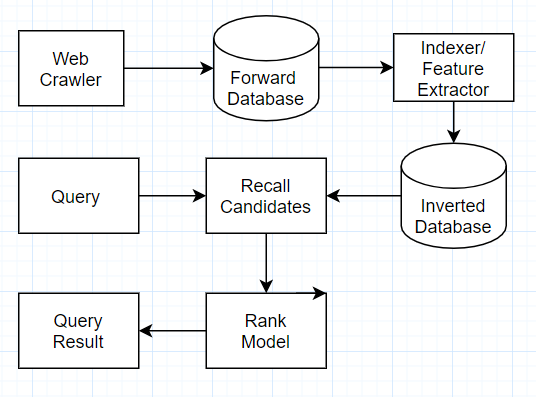Build a Simple Search System
In 2020 Sep. I implemented a simple search system from scrach. The repo is at Here. The result is something like this:

Of course, there is a story behind..
In 2020 Aug, I got interview opportunity of Apple Machine learning Engineer. Interestingly, the first interview is conducted with how to design a search system. As an algorithm developer or data scientist, I spend most of my time on applying/customizing algorithms and learning the domain knowledges. Developing simple systems is still ok to me. But a search system? Never done it before. Absolutely unexpected and of course, it went south.
The failure motivates me to implement a simple search system from scratch. The following are the summary of what I learned and implemented.
1. Project Introduction
A simple search system that mostly written in python. Usually, a search/recommend system is composed by several key components (1) Web Crawler (2) Indexing (3) Recall model/mechanism (4) Rank model (5) Query Web-Interface.

1.1 Web Crawler
-
Using selenium and beautifulsoup4 to fetch the data from https://stackoverflow.com that mostly related to database. In addition, currently only crawling the title as document for storage concerns. This reop use sqlite3 as forward-database for simplicity.

1.2 Indexing
-
Using nltk and gensim to do the text normalization, stemming, lemmatization and doc2vec.
-
Using a customized object as inverted (index) database. For real applications, we can chose leveldb, dynamodb or rockdb. The customized object is basically a k-value object with the optimization that applies tire-tree on inverted index.
index (key word) Value sql [ (doc_id, term_frequency), …] database [ (doc_id, term_frequency), …] -
There are many advanced efficient index way, and for vector-database the indexing method often consisted of clustering and quantization methods.
1.3 Recall Model / Mechanism
- Here using traditional bool-query. It could be further enhance with term-frequency or even a model to recall the candidates.
1.4 Ranking Model / Mechanism
-
Here using Doc2Vec from gensim. The pretrained weight is from https://github.com/jhlau/doc2vec.
-
The idea is to recommend the item base on vector similarity after recall-model.
1.5 Query Interface
-
Using Flask and Jinja template with bootstrap UI framework.

2. Usage Flow
- install the requirement packages
- install chrome driver for selenium in data/web_driver
- It should align with the config.py
- python run_web_crawler.py
- It would create a forward database and storing blob in local machine.
- python run_model_indexer.py
- It would run text normalization and then build the inverted-index object.
- python run_query_interface.py
- It would run a flask server on localhost:5000.
- Config File
- forward_database = r‘data/sqldb/example.db’
- inverted_database = r‘data/sqldb/inverted_key_word_db.pkl’
- Doc2Vector300D_model_weight = r“data/model/doc2vec.bin”
3. Result Comparison
Current result just using traditional bool query, and not counting lots features like voting, user persona, content of question, and content of reply answers.
| This Repo | Original Website |
|---|---|

|

|
4. Further Improvement
- There are lots of things we could improve on and play with:
- Model-based recall mechanism: Personally, I also build the vectors database of title-text, however not index it yet for fast-read. There are some ways to index the dense-vector database via some clustering or quantization methods. I would like to try some of them after more understanding of them. Also, I am not sure how much improvement would it bring to the overall performance.
- Stronger Ranking model: There are many rooms to improve the ranking model, like taking extra-features into the model or using a better model.
- Distributed Storage: we definitely can shading the database, both on forward-database and inverted database.
- Crawling for more content: Due to storage limitations, I treat the title of the document as entire document. However, we could also crawling and parsing content as well.
- Advanced Indexing method: if the data is large, we may need to do some compression on index. In addition, for dense vector-based search/recommend system, we may need to using clustering/product quantization plus multi-index method to index the database. There are several famous method like Non-Orthogonal Inverted Multi-Index or IVFADC.